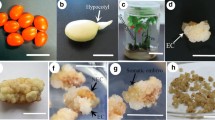Summary
Media components used for three stages of development: (1) callus maintenance, (2) maturation of embryos, and (3) conversion of embryos to plants were shown to affect regeneration of plants for the commercially important red rose cultivar Kardinal. Embryogenic callus was maintained for 5yr on either Schenk and Hildebrandt’s basal salts medium (SH) supplemented with 13.6 μM 2,4-dichlorophenoxyacetic acid (2,4-D) or Murashige and Skoog’s basal salts medium (MS) supplemented with 18.1 μM dicamba and 0.46 μM kinetin. Maturation of embryos was three times higher using callus maintained on the SH medium supplemented with 2,4-D while conversion of cotyledonary-stage embryos to plants was significantly higher (10 times) using callus that had been maintained on MS medium with dicamba and kinetin. Maximum maturation (13.5%), and conversion (15.2%), occurred when callus was cultured on MS maturation medium without hormones. Cotyledonary-stage embryos cultured on MS conversion medium supplemented with abscisic acid (5–20 μM) produced plants that survived at a significantly higher rate (two times) in the greenhouse than when embryos were cultured without abscisic acid. The highest rate of plant regeneration occurred when embryogenic callus of ‘Kardinal’ was maintained on MS medium supplemented with dicamba and kinetin, maturation of embryos occurred on MS maturation medium without hormones, and conversion of cotyledonary-stage embryos occurred on MS conversion medium supplemented with abscisic acid.
Similar content being viewed by others
References
Castillon, J.; Kamo, K. Maturation and conversion of somatic embryos of three genetically diverse rose cultivars. HortScience 37:973–977; 2002.
Cheng, W. H.; Endo, A.; Zhou, L.; Penney, J.; Chen, H. C.; Arroyo, A.; Leon, P.; Nambara, E.; Asami, T.; Seo, M.; Koshiba, T.; Sheen, J. A unique short-chain dehydrogenase/reductase in Arabidopsis glucose signaling and abscisic acid biosynthesis and functions. Plant Cell 14:2723–2743; 2002.
Derks, F. H. M.; van Dijk, A. J.; Hanisch ten Cate, C. H.; Florack, D. E. A.; Dubois, L. A. M.; de Vries, D. P. Prolongation of vase life of cut roses via introduction of genes coding for antibacterial activity, somatic embryogenesis and Agrobacterium-mediated transformation. Acta Hort. 405:205–209; 1995.
De Wit, J. C.; Esendam, H. F.; Honkanen, J. J.; Tuominen, U. Somatic embryogenesis and regeneration of flowering plants in rose. Plant Cell Rep. 9:456–458; 1990.
Dunstan, D. I.; Dong, J. Z.; Carrier, D. J.; Abrams, S. R. Review. Events following ABA treatment of spruce somatic embryos. In Vitro Cell. Dev. Biol. Plant 34:159–168; 1998.
Firoozabady, E.; Moy, Y.; Courtney-Gutterson, N.; Robinson, K. Regeneration of transgenic rose (Rosa hybrida) plants from embryogenic tissue. Bio/Technology 12:609–613; 1994.
Hsia, C.; Korban, S. S. Organogenesis and somatic embryogenesis in callus cultures of Rosa hybrida and Rosa chinensis minima. Plant Cell Tiss. Organ Cult. 44:1–6; 1996.
Kintzios, S.; Manos, C.; Makri, O. Somatic embryogenesis from mature leaves of rose (Rosa sp.). Plant Cell Rep. 18:467–472; 1999.
Kunitake, H.; Imamizo, H.; Mii, M. Somatic embryogenesis and plant regeneration from immature seed-derived calli of rugosa rose (Rosa rugosa Thunb.). Plant Sci. 90:187–194; 1993.
Li, X.; Krasnyanski, S. F.; Korban, S. S. Somatic embryogenesis, secondary somatic embryogenesis, and shoot organogenesis in Rosa. J. Plant Physiol. 159:313–319; 2002a.
Li, X.; Krasnyanski, S. F.; Korban, S. S. Optimization of the uidA gene transfer into somatic embryos of rose via Agrobacterium tumefaciens. Plant Physiol. Biochem. 40:453–459; 2002b.
Marchant, R.; Davey, M. R.; Lucas, J. A.; Power, J. B. Somatic embryogenesis and plant regeneration in Floribunda rose (Rosa hybrida L.) cvs. Trumpeter and Glad Tidings. Plant Sci. 120:95–105; 1996.
Merkle, S. A.; Parrott, W. A.; Flinn, B. S. Morphogenic aspects of somatic embryogenesis. In: Thorpe, T. A., ed. In vitro embryogenesis in plants. Dordrecht: Kluwer Academic Publishers; 1995:155–203.
Misra, S.; Attree, S. M.; Leal, I.; Fowke, L. C. Effect of abscisic acid, osmoticum, and desiccation on synthesis of storage proteins during the development of white spruce somatic embryos. Ann. Bot. 71:11–22; 1993.
Murali, S.; Sreedhar, D.; Lokeswari, T. S. Regeneration through somatic embryogenesis from petal-derived calli of Rosa hybrida L. cv Arizona (hybrid tea). Euphytica 91:271–275; 1996.
Murashige, T.; Skoog, F. A revised medium for rapid growth and bioassays with tobacco tissue cultures. Physiol. Plant. 15:473–497; 1962.
Noriega, C.; Sondahl, M. R. Somatic embryogenesis in hybrid tea roses. Bio/Technology 9:991–993; 1991.
Rout, G. R.; Samantaray, S.; Mottley, J.; Das, P. Biotechnology of the rose: a review of recent progress. Sci. Hort. 81:201–228; 1999.
Sarasan, V.; Roberts, A. V.; Rout, G. R. Methyl laurate and 6-benzyladenine promote the germination of somatic embryos of a hybrid rose. Plant Cell Rep. 20:183–186; 2001.
Schenk, R. U.; Hildebrandt, A. C. Medium and techniques for induction and growth of monocotyledonous and dicotyledonous plant cell cultures. Can. J. Bot. 50:199–204; 1972.
van der Salm, T. P. M.; van der Toorn, C. J. G.; Bouwer, R.; Hanisch ten Cate, C. H.; Dons, H. J. M. Somatic embryogenesis and shoot regeneration from excised adventitious roots of the rootstock Rosa hybrida L. ‘Moneyway’ Plant Cell Rep. 15:522–526; 1996.
van der Salm, T. P. M.; van der Toorn, C. J. G.; Bouwer, R.; Hanisch ten Cate, C. H.; Dons, H. J. M. Production of ROL gene transformed plants of Rosa hybrida L. and characterization of their rooting ability. Mol. Breed. 3:39–47; 1997.
van der Salm, T. P. M.; van der Toorn, C. J. G.; Hanisch ten Cate, C. H.; Dubois, L. A. M.; De Vries, D. P.; Dons, H. J. M. Importance of the iron chelate formula for micropropagation of Rosa hybrida L. ‘Moneyway’. Plant Cell Tiss. Organ Cult. 37:73–77; 1994.
Author information
Authors and Affiliations
Corresponding author
Rights and permissions
About this article
Cite this article
Kamo, K., Jones, B., Bolar, J. et al. Regeneration from long-term embryogenic callus of the Rosa hybrida cultivar kardinal. In Vitro Cell.Dev.Biol.-Plant 41, 32–36 (2005). https://doi.org/10.1079/IVP2004599
Received:
Accepted:
Issue Date:
DOI: https://doi.org/10.1079/IVP2004599




